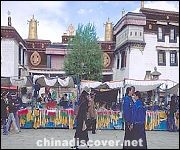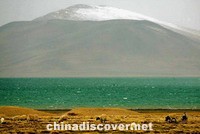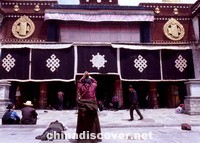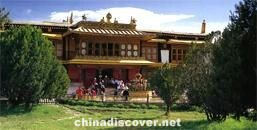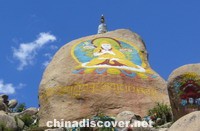Potala Palace
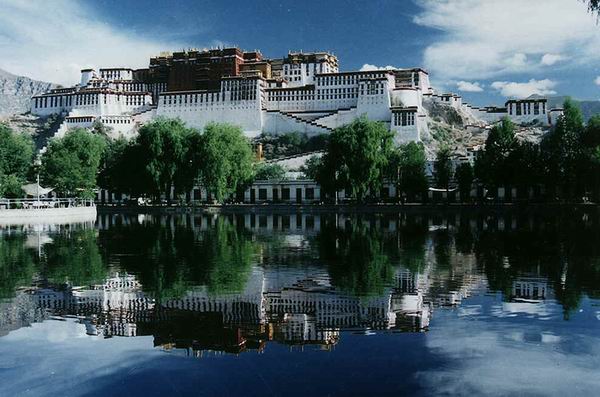
Potala Palace the architectural wonder is Lhasa's cardinal landmark. It can be seen from all directions for miles around.
With its world-wide reputation, the Potala Palace stands on the Red Hill overlooking the Tibetan city of Lhasa as a major national cultural monument. This architectural wonder is Lhasa' cardinal landmark. It can be seen from all directions for miles around. Potala was set up in the seventh century AD during the reign of King Songtsen Gampo. It's located on the Red Hill, covers an area of 41 hectares.
Potala consists of the White and Red palaces with more than 1000 rooms. The white places was for secular use. It contained living quarters, offices, the seminary and the printing house. The red Palace's function was religious. It contained gold stupas, which were the tombs of eight Dalai Lamas, the monks' assembly hall, numerous chapels and shrines, and libraries for Buddhist Scriptures.
With its world-wide reputation, the Potala stands on the Red Hill overlooking the Tibetan city of Lhasa as a major national cultural monument.
The name of the large sacred Buddhist building complex is a derivation from Samskrit Potalaka which is the mythical mountain abode of Avalokitesvara, one of the Bodhisattvas (Buddhist saints). In this connection Lhasa is popularly referred to as Second Mount Potalaka.
At an elevation of more than 3,700m, the Potala occupies an area of more than 360,000m. Its 13-story main portion rises 117m. The whole complex, consisting of halls, stupa-tomb halls (where the relics of the supreme lamas are preserved), shrines, prayer rooms, monks' dormitories and courtyards, is recognized as the world's highest and largest castle palace.
Built against the terraced slope of the hill, the structures combine to from a huge sky-scraping mass, reminscent of the divine realm above the mortal world. The granite walls elaborately decorated with soft white thatch, the golden roofs decorated with big gilded bottles, the splendid curtains and banners, join to form a unique structural wonder bearing the striking colors red, white and yellow characteristic of Tibetan architectural art, making the Potala an eminent example of a constructive technology traditionally Tibetan and Chinese.
As the winter residence of the successive Dalai Lamas, the Potala formerly served as the center of local Tebetan theocratic rule, hosting the major religious and political ceremonies since the reign of Dalai Lama V (1917-1682), at the same time housing the relics of those spiritual leaders.
The earliest project for the Potala started in A. D. 631 under Tibetan King Srang00brtsan-sgam-po (617?-650), which included 999 royal rooms plus a meditation chamber. That building was eventually destroyed by thunderbolts and wars.
Dalai Lama V, in his effort to consolidate his theocracy, entrusted in 1645 Bsod-glan-rab-den, his minister, with the rebuilding of the portion known as the White Palace of the Potala and also the enclosures, towers and turrets. When the project was completed, the patriarch moved his government to the new building from Bras-spungs Monastery.
Later in 1690 Prime Minister Bsam-rgya-mtsho enlarged the Red Palace as a part of his project to build Dalai Lama V's stupa-tomb. The extension was eompleted in 1693, which was to be followed by new projects sponsored by later Dalai Lamas, including 5 golden roofs and a number of accessory structures.
The Potala assumed its present form and scale in 1936 when Dalai Lama XIII's (1870-1933) stupa-tomb was completed.
The main portion of the Potala contains the White Palace and the Red Palace.
The 7-storey White Palace, Dalai Lamas' winter residence, also housed the former local Tibetan government. There the most spacious hall, the eastern Audience Hall (Sishe Phuntsok) occupies a central area of 717m on the 4th floor. It was there that the Dalai Lamas were enthroned as supreme Tibetan Buddhist spiritual leader and the region's temporal ruler.
The 5th and 6th floors bore government offices and rooms for the officials.
Two particular apartments on the top floor, reserved for the Living Buddhas, were known as Eastern and Western Sunshine Apartments for their long access to sunlight.
In constrast with the White Palace, the Red Palace consists mainly of the supreme primates' stupa-tombs and the shrines.
Of the 8 stupa-tomb halls, the most magnificent is that for the cult of Dalai Lama V. To the west his memorial hall, the Western Audience Hall, covers 725m to be the largest hall in the Potala. Of the extensive murals there the most notable one shows the patriarch's audience with Chinese Emperor Shunzhi (reigned 1644-1661) in Beijing.
A tablet overhanging the patriarch's throne bears a Chinese phrase meaning literally "The Source of Lotus Flowers" written by Chinese Emperor Qianlong (1711-1799) himself. The phrase is a metaphoric reference to the Buddhist paradies.
The Dharma-raja's Cave (Chogyal Dupup) and several other apartments dating back from the reign of the Tu-bo Dynasty (629-846)are the earliest Potala structures extant. They house a valuable collection of statues, including the sculptural representation of King Srang-brtsan-sgam-po, his consorts Princess Wencheng and Princess Khri-btsun and his prime minister Blon-stong-btsan-po.
As the most elevated hall in the Red Palace, "The Best of the Three Realms" (Sasum Namgyal) accomodates the image of Chinese Emperor Qianlong and the statue of 11-face avalokitesvare cast in more than 10,000 ounces of silver as commissioned by Dalai Lama XIII. The remains of that spiritual leader are preserved in a stupa in the neighboring hall. Construction of that hall, begun in 1933, was not completed until three years later. Thus it is the newest hall in the whole complex.
The names of other sanctuaries include:
"The Prominent Master's" (Lama Lhakhang);
"The Example of Samantabhadra" (Kunzang Jedokhang);
"The Wheel of Time" (Dukor Lhakhang);
"Sakyamuni of Loving Kindness" (Thupwang Lhakhang);
"Sakyamuni of Virtues" (Zegya Lhakhang);
"The Great Gradual Path" (Lamring Lhakhang);
"The True Word" (Rigzin Lhakhang);
"The Sacred Succession" (trungrab Lhakhang).
Subordinate constructions to the Potala include the Lam-rgyal Abbey, the Senior Seminary, the monks' dormitories and the eastern and western courtyards on the hill, while at the foot of the hill stands the houses once occupied by the local ogvernment bureaus and institutions, the printing press for Buddhist cannonical writings as well as a jail, the stables and the backyard garden.
Through more than 300 years the Potala has accumulated an enormous collection of monuments and relics. There are murals covering totally more than 2,500m, nearly 1,000 stupas, about 10,000 statues and as many thang-ka paintings, the religious library there includes puttra-leaf scriptures and the Bka'-'gyur (Buddhas's Teachings) volumes.
There are also a unique collection of golden diplomas and jade seals granted to successive Dalai lamas by Chinese Ming (1356-1644) and Qing (1644-1911) emperors to re-affirm the official ties between the local Tibetan administration and the central Chinese government. And the gold and silver artifacts, porcelain vessels, enamelwork, jadeware, brocade and other handicraft articles preserved in the Potala are enormous and richly diversified.
The beauty and originality of its architecture, its ornate decoration and its harmonious integration in a striking landscape add to its historic and religious interest. (Source: CRIENGLISH.com)

